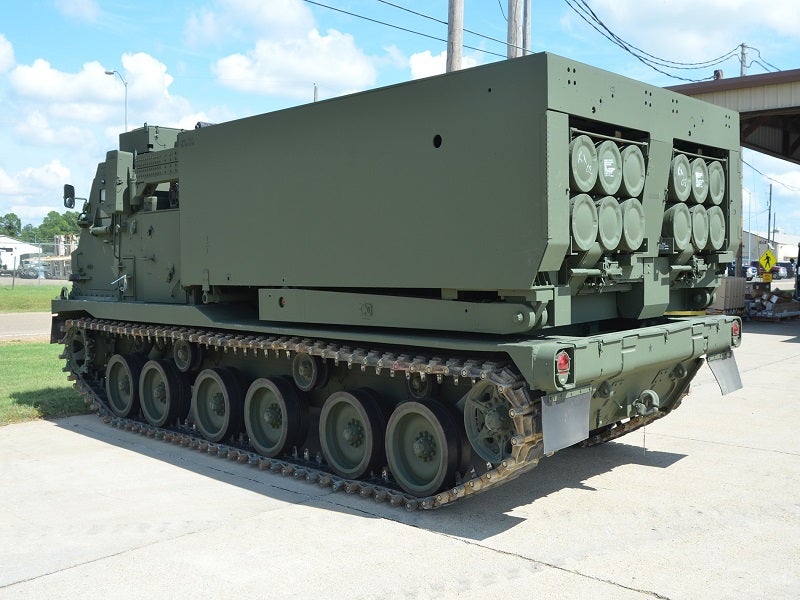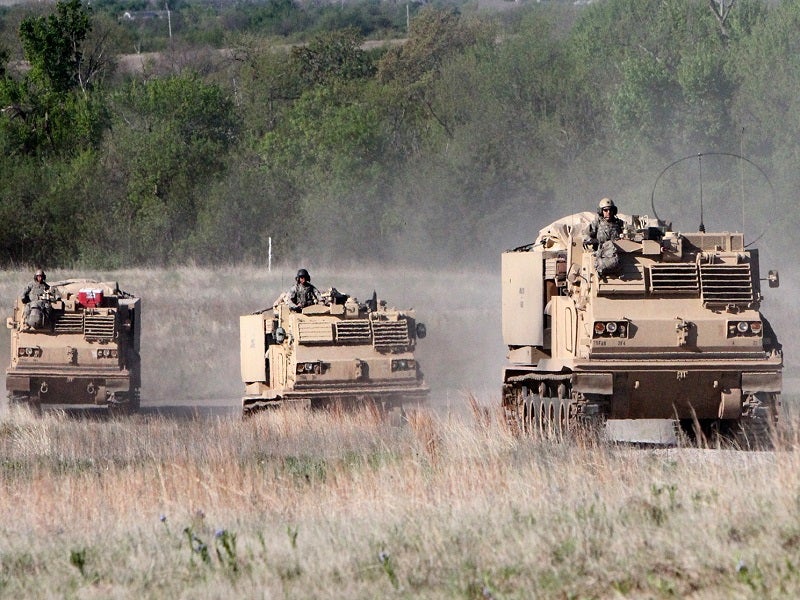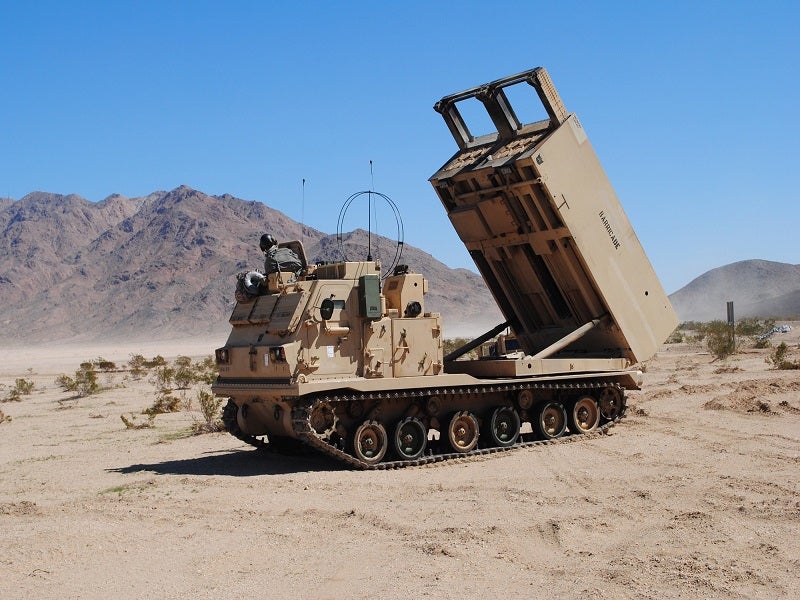Smart Rocket Launcher Rage 2
The combat-proven multiple launch rocket arrangement (MLRS) M270 is a highly mobile rocket artillery system manufactured by Lockheed Martin Missiles and Burn Control. The MLRS system is operational with the war machine of Bahrain, Finland, Egypt, France, Germany, Greece, Israel, Italy, Saudi arabia, Japan, South korea, Turkey, the US and the UK. The system is as well built in Europe by an international consortium of companies from France, Germany, Italy, and the UK.
M270 MLRS orders and deliveries
In January 2006, it was agreed that two batteries of MLRS (nine launchers a battery) were to be transferred from holland to Finland. The systems were delivered in February 2007.
MLRS was deployed in back up of Operation Iraqi Freedom in 2003. The United states Ground forces fielded the upgraded M270A1 launchers and the new ATACMS quick reaction unitary missile in Feb 2011, placing a $22.1m guild for M270 launcher upgrade kits.
The Finnish Army placed a $45.3m social club to upgrade its 22 M270 MLRS launchers in May 2011. The upgrade incorporated the universal fire control system in the MLRS, allowing the launchers to fire precision GPS-guided munitions.
Lockheed Martin received a $362m contract from the U.s.a. Ground forces to recapitalise 50 MLRS launcher systems to the latest configuration in April 2019. The US Army has plans to upgrade 225 M270A1 launchers and 160 decommissioned M270A0s to the M270A2 standard.
The company secured another contract worth $226m to refurbish 44 boosted M270s in June 2020. The US Department of Defence (DoD) awarded a contract modification worth $214.7m to Lockheed Martin Missiles and Fire Control to continue the modernisation of the M270 MLRS to M270A2, in April 2021.
The British Regular army announced a 5-year plan to upgrade its existing fleet of 44 M270 MLRS launchers in April 2021. The upgrade will add an armoured cab and modernised automotive and launcher components.
Furthermore, the U.k. volition develop country-specific components for the new launchers, including composite rubber tracks, and a vehicle photographic camera and radar system. It will also work on the development of the new burn command organisation in partnership with the US, Finland, and Italy.
M270 MLRS blueprint and features
The multiple launch rocket system is a high-mobility automatic system based on an M270 weapons platform. MLRS fires surface-to-surface rockets and the army tactical missile organisation (ATACMS). Without leaving the cab, the crew of iii (driver, gunner, and section principal) tin fire up to 12 MLRS rockets in fewer than 60 seconds.
The MLRS launcher unit of measurement comprises an M270 launcher loaded with 12 rockets, packaged in ii six-rocket pods. The launcher, which is mounted on a stretched Bradley chassis, is a highly automated self-loading and self-aiming system. It contains a fire control calculator that integrates the vehicle and rocket-launching operations.
The rockets can be fired individually or in ripples of two to 12. Accurateness is maintained in all firing modes considering the figurer re-aims the launcher between rounds.
The M270 MLRS can be readily transported to the area of operations, for example, past the C-five transporter shipping or past railroad train. MLRS offers optimal cross-country mobility and a road speed of 64km/h.
Multiple launch rocket system tactical rocket warhead and munitions
The basic MLRS tactical rocket warhead contains 644 M77 munitions, which are dispensed above the target in mid-air. The dual-purpose bomblets are armed during freefall and a simple elevate ribbon orients the bomblets for impact. Each MLRS launcher can evangelize near 8,000 munitions in fewer than 60 seconds at ranges exceeding 32km.
Other mission-oriented rockets include the extended-range (ER) rocket, the reduced-range practice rocket (RRPR) with a range of 8km to 15km, and the AT2, which dispenses 28 antitank mines a round. The extended-range rocket was first fielded in 1998 and carries 518 improved munitions in excess of 45km.
M270 MLRS fire control
The MLRS computerised fire control system enables a reduced crew, or even a single soldier, to load and unload the launcher. A portable smash control device and cable hook assembly is used for loading and unloading. The fire command estimator allows firing missions to exist carried out either manually or automatically.
In a typical burn mission, a command mail service transmits the selected target data straight to the MLRS computer.
The computer aims the launcher and prompts the coiffure to arm and fire a pre-selected number of rounds. Multiple mission sequences tin can exist pre-programmed and stored in the calculator.
ATACMS (ground forces tactical missile system)
MLRS also fires the long-range Lockheed Martin Army Tactical Missile System (ATACMS) guided missiles. The ATACMS family includes the cake 1, block 1A and block 1A unitary missiles. Block 1, which was used during Operation Desert Storm, carries 950 baseball game-sized M74 submunitions to ranges exceeding 165km.
The block IA missile extends the range to more than 300km by reducing the submunition payload and adding GPS guidance. The cake 1A unitary missile, with a single-outburst warhead, was starting time deployed in support of Operation Iraqi Freedom in March / Apr 2003.
Lockheed Martin was awarded a first US Army contract for the production of the unitary missile in February 2004 and a 2nd, for 50 missiles, in January 2005.
The plan to develop the block Two missile, with GPS and thirteen BAT (vivid anti-tank) submissiles, and Block IIA missile, with half dozen improved BAT submissiles, was cancelled in February 2003. The BAT submunition, manufactured by Northrop Grumman, is an unpowered glider, which has acoustic sensors for target detection and infrared sensors for terminal guidance. Its maximum range is 140km.
Guided multiple launch rocket organization (GMLRS)
Lockheed Martin developed a new extended-range guided MLRS (GMLRS), which has a range of more than 70km. The GMLRS XM30 rocket has a GPS (global positioning arrangement) and inertial guidance packet and small canards on the rocket nose to raise accurateness.
GMLRS completed system development and sit-in (SDD) tests in December 2002 and entered low-rate initial product in Apr 2003. A total of 156 GMLRS rockets were produced under the LRIP I contract (deliveries completed May 2005), 840 under the LRIP II (awarded in March 2004), and 1,014 nether LRIP III (awarded February 2005).
Initial operational capability (IOC) was achieved in 2006, but the system has been operationally deployed since September 2005 in Republic of iraq. The GMLRS is an international programme involving the UK, Italy, French republic and Germany, as well as the US. The industrial team includes Diehl, MBDA and FiatAvio.
The production milestone of the l,000th GMLRS rocket was achieved in Jan 2021.
The next-generation extended-range guided multiple launch rocket system (ER GMLRS) munition was successfully flight-tested from the US Ground forces'due south HIMARS launcher at White Sands Missile Range, New United mexican states, in March 2021. Deployable by HIMARS and the MLRS M270 family of launchers, the ER GMLRS provides an increased range of up to 150km.
GMLRS orders and deliveries
In August 2005, the UK placed a contract for GMLRS, becoming the get-go international customer. GMLRS entered service with the U.k. Army Majestic Artillery in Apr 2007 and began deployment to Afghanistan in June 2007.
First deliveries of a unitary variant of GMLRS, with a single 81.6kg (180lb) warhead and a range of up to 70km, were made in May 2005. In October 2003, Lockheed Martin was awarded an SDD contract for 86 unitary variant rockets, delivered in June 2005.
The program was accelerated following a Us Army 'urgent need' statement in January 2005, and the starting time 72 GMLRS unitary rockets were delivered in June of that yr. Lockheed Martin conducted 17 tests on the unitary variant in 2006. In June 2007, GMLRS Unitary entered low-charge per unit initial production (LRIP). Operational testing was completed in April 2008. A follow-on contract was awarded in Baronial 2008. Lockheed Martin was awarded a $512m contract to supply GMLRS and HIMARS launchers to the US Army and US Marine Corps, in January 2008.
The U.s. Army placed a $603m order for GMLRS and HIMARS launchers in February 2009. Lockheed Martin delivered the 10,000th GMLRS to the The states Army in April 2010.
Lockheed Martin was awarded a $445m follow-on contract by the US Ground forces for 735 GMLRS unitary rocket pods and 508 RRPR pods in June 2011. The U.s.a. Department of Defense force placed a $79.4m order for the development of a new GMLRS variant with a new warhead in Apr 2012.
In July 2012, the United states Army placed a $353.2m order for the seventh production lot of GMLRS unitary rockets. The 20,000th GMLRS unitary rocket was delivered to the US Army in August 2012.
Lockheed Martin was awarded a $197m contract pick by the US Army in January 2013, bringing the GMLRS production lot 7 contract value to $550.8m.
The company received a $331m contract from the United states of america Ground forces for the 11th production lot of GMLRS rockets in June 2016.
Lockheed Martin secured a $471m contract from the United states of america Army for the 12th production lot of GMLRS rockets in July 2017, followed by a contract worth $828m from the U.s.a. Ground forces for the 13th production lot in May 2018.
Lockheed Martin was awarded a $one.13bn contract by the United states Army for the 14th product lot of GMLRS rockets and associated equipment in March 2019. A contract worth $1.12bn for the 16th production lot covering the production of more than than 9,000 GMLRS unitary and alternative-warhead rockets and over 2,000 low-cost RRPRs was awarded to the company in March 2021.
M270A1 upgrade
In Dec 2000, a low-rate initial production contract was placed with Lockheed Martin for 66 upgraded M270A1 launchers for delivery past 2004. MLRS launchers upgraded to M270AI
status take improved burn down control systems (IFCS) and improved launcher mechanical systems (ILMS).
The M270A1 launcher completed operational testing in October 2001 and was first fielded in May 2002. Lockheed Martin also received a foreign armed forces sales (FMS) contract for the new launchers from the Republic of Korea.
The IFCS provides additional capacity to accommodate circuitous munitions and modernistic figurer electronics, including video display, onboard navigation with global positioning system, compages for ultrafast signal processing and avant-garde mission software. ILMS reduces the time to aim the launcher to sixteen seconds (compared to 93 seconds). The reloading time is cut from four to three minutes.
UK systems also received the IFCS. The first 15 systems for the United kingdom were ordered in March 2005 for commitment by the end of 2006. Italian, German, and French MLRS systems feature the European burn down control systems (EFCS) developed past EADS / Dornier.
The M20A2 upgrade
The M20A2 configuration will take a cypher-time launcher, a new engine, and an improved armoured cab. The new mutual burn control organization (CFCS) to exist integrated into the M20A2 will provide commonality with the HIMARS and combability with the future MLRS family unit of munitions (MFOM).
The improved cabs will increase the interior book significantly, while the seats will be designed with energy-absorbing capability and will protect the occupants from mine blasts and improvised explosive devices (IEDs). The fire control console of the MLRS will likewise be upgraded.
Topics in this article:
Smart Rocket Launcher Rage 2,
Source: https://www.army-technology.com/projects/mlrs/
Posted by: densonthoseltogs.blogspot.com





0 Response to "Smart Rocket Launcher Rage 2"
Post a Comment